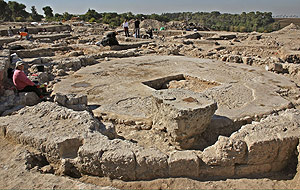
The round structure built of well-dressed ashlar stones uncovered in the IAA's excavation at Mishmar David
Evidence of an ancient settlement was uncovered in the IAA excavations that were conducted at Mishmar David at the request of the Israel Lands Administration. The construction and development at the site will be carried out taking into consideration the unique ancient remains and incorporating them into the new settlement.
In the salvage excavations the Israel Antiquities Authority is carrying out at Mishmar David, at the request of the Israel Lands Administration, the remains of a large settlement that dates from the Early Islamic period to the Crusader period were exposed. Residential buildings, villas, public buildings, streets and alleys, and an industrial region in which there are agricultural installations etc were discovered at the site. The highlight of the excavations is a round structure built of well-dressed ashlar stones, c. 10 m in diameter and preserved to a height of 3 m. The floor of the structure is paved with a polychrome mosaic decorated with geometric patterns and a palm tree motif. Archaeologists from the Israel Antiquities Authority said this is a unique building, the kind of which has not been encountered to date in any other archaeological excavations in the country. “The building indeed dates to the Byzantine-Islamic period but the nature of it and its purpose are unclear”, it was reported.
Dr. Eli Yannai, director of the excavation on behalf of the Israel Antiquities Authority, noted that buildings such as the one that was uncovered were usually meant to commemorate an important historic event that was of significance to the population that resided there. “It can be a building that was erected in memory of a person who was martyred because of his religious beliefs, a miracle that occurred at the site or a visit by a saint”, Yannai said.
The importance of the excavation finds and their contribution to the study of the past lie in the intensity of the remains, the size of the Umayyad settlement which extends across c. 6 dunams and the evidence that the population that lived there was a Christian population prior to it having converted to Islam. The findings that support this assumption are unequivocal Christian symbols such as crosses that were revealed on clay lamps and inscriptions in ancient Greek that mention “the mother of God” – a Christian saying that was characteristic of the Byzantine period. In addition to this is the presence of an industrial zone for the large scale production of wine intended for consumption by the local residents and for commercial requirements. On the other hand the bronze coins that were recovered at the site bear the names of caliphs from the Early Islamic period and some of them were struck with the following Arabic inscription: “There is no God but Allah and Muhammad is his servant”.
Additional Articles ...